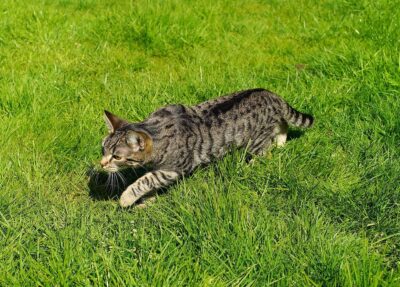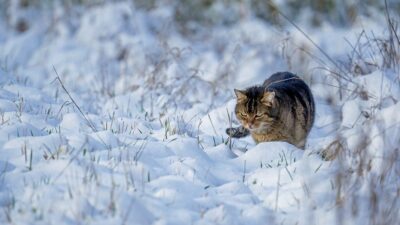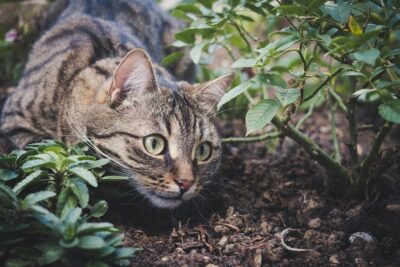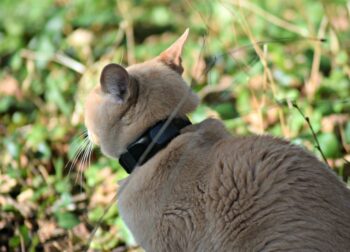Do you let your cat roam freely outdoors? If so, do you know where he goes and what he does? Have you ever wished you could learn about the secret life of a cat? In this report, you may find some surprising answers.
In writing this post, I have reviewed four reports on the subject. In the United States, one report came from the University of Georgia, and one from a two-year study performed by the University of Illinois. In Great Britain, a research project by BBC2’s Horizon and the Royal Veterinary College provided information, and a second study which tracked the movements of six cats, also came from Great Britain.
In Britain, only 26% of pet cats remain indoors, while the others can roam free. In the United States, a much higher number of the cats remain indoors. These studies focused on the cats who could roam as they wished.
Study from University of Georgia and National Geographic Society
For this post, I will discuss each of these studies separately. First is the University of Georgia, working with the National Geographic Society. These folks used collars with critter cameras, tiny cameras developed by National Geographic. Researchers put these cameras on the collars of 55 cats in Athens, Georgia. They gathered thousands of hours of tape as the cats roamed through suburban neighborhoods.
Wildlife ecologist Kerrie Anne Loyd led the research team. She found that 44% of the cats exhibited hunting behavior,  and of these, 30% successfully captured animals.
and of these, 30% successfully captured animals.
She found it surprising, what these cats captured. They caught lizards and small snakes, probably because these were readily available. In a different geographic area, the prey might be very different.
The Georgia cats also caught woodland voles, chipmonks, a squirrel, and such invertebrates as earthworms, moths, and dragonflies, but in this area they caught only a small number of birds.
Loyd discovered that ten of the cats in their study regularly sat under bird feeders; however, they caught no birds from this practice. They must have made the birds a little nervous, however.
Some of the cats really surprised their owners, when they learned that the cat went into another household, where it was petted and fed, so they basically cheated on their original owners.
Others just sat on the porch, waiting for their humans to come home.
Loyd drew some conclusions from this study. She suggests that, if you know your cat hunts, observe more closely when the cat goes outdoors. During the warmer season, keep them inside more, as the researchers found more cats exhibiting hunting behavior when the weather became warmer.
Loyd also suggests a cat bib. This bib, costing about $10.00, looks like a baby bib, but it’s a heavier material. When the cat wears it, the length and weight prevent him from being able to pounce on a prey in the usual manner.
I tried such a bib on my cat, Carlos, when I lived in Bells Flats outside of Kodiak. It certainly worked, to the disgust of the cat.
However, he found a way to deal with the problem. Some birds build nests on the ground, and Carlos found one of these. I’m guessing he ate all the babies except one. That one he brought home to me, dead, of course. As he preferred hunting full-grown rabbits, I don’t believe he’d ever stooped so low before in his hunting practice as to kill infants.
I was horrified! I got the message right away. I took the bib off and never put it on him again.
Study from University of Illinois
The next study from the University of Illinois covered a time period of two years. For this study,42 free-roaming cats, outfitted with radio collars, participated. Of these, 18 were pets and 24 had no owner.
Goals of the research team included a comparison between the owned cats versus the unowned ones, including what they did, where and how far they wandered, and how likely they were to survive in the outdoor world.
As all of you familiar with cats will know, these felines spent a great deal of time lounging or sleeping. Interestingly, though, the pet cats lazed around for 80% of their days, while the ownerless cats only loafed for 62% of the time.
That information makes sense. An unowned cat would want to spend more time looking for its next meal, while the pet knew he would be fed at home. Also, unowned cats roamed much further afield than owned cats. Strays also hung out in a more diverse selection of habitats, while pet cats stayed close to home. One stray wandered around a 1,351-acre area.
Researchers found that the unowned, free-range cats faced much higher risks to their safety, and indeed, in this study, six stray cats died compared to one owned cat.
six stray cats died compared to one owned cat.
Unfortunately, some scientists feel that free-range cats, owned or unowned, have become a conservation and safety concern. The concern stems from the sheer number of cats — according to whyfiles.org, in the United States alone, more than 90 million cats share the homes of humans, while another estimated 90 million classify as stray or feral.
Like any species, too many can create trouble. Cats are superb predators, and this prowess, plus the overpopulation creates concern over the potential endangerment or extinction of some prey species. In fact, 33 bird species have been eliminated, supposedly by the cat, since the 1600s.
According to Stanley Temple, emeritus professor of forest and wildlife ecology at the University of Wisconsin-Madison, free-range cats are not only the most abundant medium-size predators in many landscapes, but they can outnumber the native mammalian mid-sized predators combined.
Because of the impact on both natural predator and prey, conservation scientists consider them an invasive species. Though they are not the greatest threat to wildlife, they add to the threat.
As the most at-risk birds are those who spend a lot of time on the ground, birds in America’s dwindling grasslands or at the crowded seashore, find themselves in a precarious situation.
The impact of free-roaming cats was first given attention when one cat took out an entire species of bird. A lighthouse keeper brought his pet cat to his post on the uninhabited Stephens Island off the coast of New Zealand. The cat, who roamed free, brought back gifts for his owner, and one an unfamiliar species of bird.
The lighthouse keeper preserved some of this species to show mainland scientists, and they confirmed that the birds belonged to a new species, which they called the Stephens Island wren. When the scientists got to the island to check these birds, there were no survivors, as the cat had done them all in.
Concern has also been raised that these cats could easily spread diseases and parasites from cat to cat, cat to wildlife, and even cat to human. Vaccination helps, but some cats never get the vaccination.
Keeping all pet cats indoors would help, but not all pet owners are willing to comply. I know with Carlos, keeping him inside would have proved well-nigh impossible. He would have tried all possibilities until he saw a chance to escape.
Professor Temple believes that to control the cat population, three criteria need to be met:
- The strategy must control cat numbers over large areas
- It can’t harm any other part of the ecosystem
- It must be socially acceptable
The debate involves one group that has become really concerned about the ecological impact of cats and one group having great concern about the welfare of individual animals.
Temple believes solutions that can be agreed upon by both groups do exist. He feels that keeping pets inside or trapping, neutering, and confining unowned free-range cats represent two strategies that would work.
But where would you confine these feral cats? Free-range cats present a problem that needs a solution.
Project from BBC2’s Horizon and the Royal Veterinary College
Now, for a look at the reports from Great Gritain: The first one, a project by BBC2’s Horizon and the Royal Veterinary College set out to track cats to see what they do when off alone.
 he equipment this group used involved very specialized wildlife tracking tags and collars. This included a combination of high-accuracy GPS and electronic sensors. The equipment had to be small enough and light enough for a domestic cat to wear on a safety-release collar.
he equipment this group used involved very specialized wildlife tracking tags and collars. This included a combination of high-accuracy GPS and electronic sensors. The equipment had to be small enough and light enough for a domestic cat to wear on a safety-release collar.
As GPS uses lots of power, to save the battery, the team used an activity sensor to trigger the GPS only when the cat moved. The village of Shamley Green in Surrey became the chosen site for the study.
The study involved 50 cats, placed under surveillance 24 hours a day. I could find nothing telling how long this study lasted.
I checked Youtube for some videos from this study. The two I found were not available at my location. Therefore, if you want to check for yourself on Youtube, look for BBC2’s Horizon program to see if you can watch them.
Meanwhile, I found one article from winnring.com that gave a bit of general information about the research team’s findings and found this data.
1) Though we have considered cats natural hunters, they don’t hunt as much as we thought. When a cat chases prey, it’s not necessarily in order to eat them. A cat has an instinct to go after anything that moves; however, perhaps not for a meal, but just for play.
One night a vole that Carlos had brought in the house alive and who had escaped under the refrigerator, came out to look around. The cat heard him and gave chase. Vole and cat raced into the bedroom and over the bed. Then, the vole darted under the closet door.
I opened the door, put Carlos inside, and shut the door again. After about 20 minutes, when I’d heard nothing, I opened the door. I found the vole at one end of the closet and the cat at the other, staring at each other. The vole must have realized that if he moved, the cat would be on him.
I opened the door and the cat came out. The vole darted past him and into the living room. The cat lost interest. I ended up sweeping the vole out the open front door. Carlos didn’t want to eat that vole; he just wanted to play with it.
It seems that as the cat evolves, it leaves behind some of its instincts, including hunting. It would be interesting to find more information on this topic, as it could denote an improvement in the damage done by the cat as predator. I am guessing that this condition may apply to well-fed house pets, not to ferals and strays.
2) Cats take advantage of every opportunity. No matter how well you feed your cat, he may enter other houses to receive or to steal food.
3) Though at times fights happen, cats do their best to avoid such conflicts. If a cat knows that a certain area contains a cat that he might confront, he will turn around and go another way.
4) A cat may walk a long distance. He may not necessarily know his destination, but he always knows how to return home.
5) Cats create a special way of communicating through meows and purrs.
It is unfortunate that Horizon and BBC2 did not release a long post about their findings. Perhaps in your location, you can access the videos.
Siri Kale’s research project
Our second report from Great Britain comes from a story from theguardian.com. In this story, thanks to Tractive, manufacturers of GPS trackers, the researcher could track six cats from Lewisham, south London, over a period of a week.
Siri Kale, who implemented the study, put a tracker on her cat, Larry. Siri lives behind a busy railroad track, with trains running pretty constantly into London. The track rises about 30 feet up from ground level, and Siri didn’t think her cat could climb that high, but he can — and he crosses the track.
trains running pretty constantly into London. The track rises about 30 feet up from ground level, and Siri didn’t think her cat could climb that high, but he can — and he crosses the track.
Not only does Larry cross the dangerous tracks, but he also crosses streets around her house. Siri says he doesn’t go more than 100 metres in any direction, looping her home like a security grid.
A cat will self-limit how far they will go, especially inn an area densely populated with cats, because he doesn’t want to challenge or be challenged by other cats. Because cats are so territorial, they tend to stay in their own territory and avoid that of other cats.
Another of the cats, Pablo, traveled 4 1/2 miles in his daily jaunts. His owner thought he’d be sitting in some old lady’s living room, but he has a few hang-out spots.
Pablo also crosses busy roads. His owner believes the cat should allowed outdoors, so he can do what comes naturally to him. With giving him this freedom comes anxiety, but the owner feels it’s like letting your kids become more independent. “You have to let them go at some point,” she says.
Though there is “no clear scientific evidence” that cats can cause the bird population to decline, some birders in Britain feel that cats should be kept indoors. According to John Bradshaw, author of “Cat Sense: The Feline Enigma Revealed”, more birds in the city meet their death by flying into the glass window on a skyscraper than by cats.
One of the cats, Marina, had been harassing neighbors for food. She went to a nearby construction site and spent the night there. Her owner went to collect her, and found a guy on his break, petting her.
 The article suggests ways to help control the cat’s impact on the local bird or small-mammal population. Bells on collars help. Switching to a premium, high-protein food diet makes him less eager to hunt for more food. Give the cat mental stimulation by playing with him in the morning.
The article suggests ways to help control the cat’s impact on the local bird or small-mammal population. Bells on collars help. Switching to a premium, high-protein food diet makes him less eager to hunt for more food. Give the cat mental stimulation by playing with him in the morning.
These actions can cause quite a reduction in the amount of wildlife a cat kills. These positive actions on the owner’s part can also have a positive outcome on the cat’s behavior.
One cat seemed to be acting as the guardian of the house, as she came in when the owners left.
Another owner saw that her cat spent an unlikely amount of time in his neighbor’s garden. When asked if she put out food for the cat, she smiled and said, “Yes, I’ve been putting it out back so you couldn’t see it.”
Cats will explore people’s homes and beg for food on a set route. Researchers have found it very common for cats to be fed multiple times a day. One cat in the research program had four owners. I refer to this kind of cat as an “opportunist pig.”
This action on the part of cats and strangers is known by researchers as “cat seduction.”
Do you want to find out what your cat gets up to when it goes out that cat door? You can do your own personal study by clicking on the link provided at the end of this post, and ordering a cat tracking device. As an Amazon associate, I will receive a small commission if you purchase.
References I used for this post:
npr.org/2012/08/10/158589981/kitty-cam-reveals-the-secret-life-of-roaming-cats
whyfiles.org/2011/the-secret-life-of-cats/index.html
bbc.com/news/science-environment-22821639
winring.com/the-secret-life-of-cats/
If you would like to find out your cat’s secrets, here is a tracker collar you can try.
Waterproof tracking collar for dogs and cats, APP control
Price: $48.98
Not eligible for Prime



We have three cats but they are all indoor pets. There are coyotes, owls, and hawks that prowl outdoors so they would not be safe. I found this article on the outdoor life of cats fascinating. Their tendency to court the attention of other humans for food and attention does not surprise me. If I had an outdoor cat I would get that tracker to see where all it goes.
Keep writing these great articles on cats.
Thanks for the compliment, Edwin, and thanks for reading and leaving a comment. Our little kitties are fascinating animals, and I am enjoying learning things about them I never knew. Then I can pass the info on to you. Yes, a tracker would be interesting to have for your cat. Then we could learn all their secrets.
I never even considered where a cat goes when it’s allowed to roam free. Even though I’m not a very big cat person I would be interested to watch video of what a cat does when no one is around. Nature acting naturally is one of the most fascinating things.
To me, it would be very enlightening to know where my cat spends his time during the day. I hear about some of his escapades from time to time, but would love to have a tracker for him to wear.
Hi Fran. Thank you for very interesting article. I had cats for whole my life but U wasn’t aware that so many universities are conducting serious studies regarding their behaviors. This is absolutely fascinating and I learnt so many new things from your post. And tracker collar is great idea to check in practice what my cat is doing outside. Looking forward to test it !
I, too, think it would be most interesting to try a tracker collar to see what I learn. Cats lead these mysterious, private lives when they are away from us. It would be fascinating to learn what they are up to.
What an eye-opening article about the secret life of a cat! I do know how innately independent cats are, however, I learned a lot about what they do when they are outside on their own. I have a few friends who are cat enthusiasts and would love to know more about this tracking collar to see what their cats get up to when they are being independent. I will have to point them this way!
Hey, Daniel, thank you, and hope your friends stop by. It’s rather fascinating to think that they have that other, secret life that is unknown to us. (Cats, that is — not your friends, though they probably do as well.) Cats are always surprising me, and I’ve lived with a lot of them. They are an amazing animal!